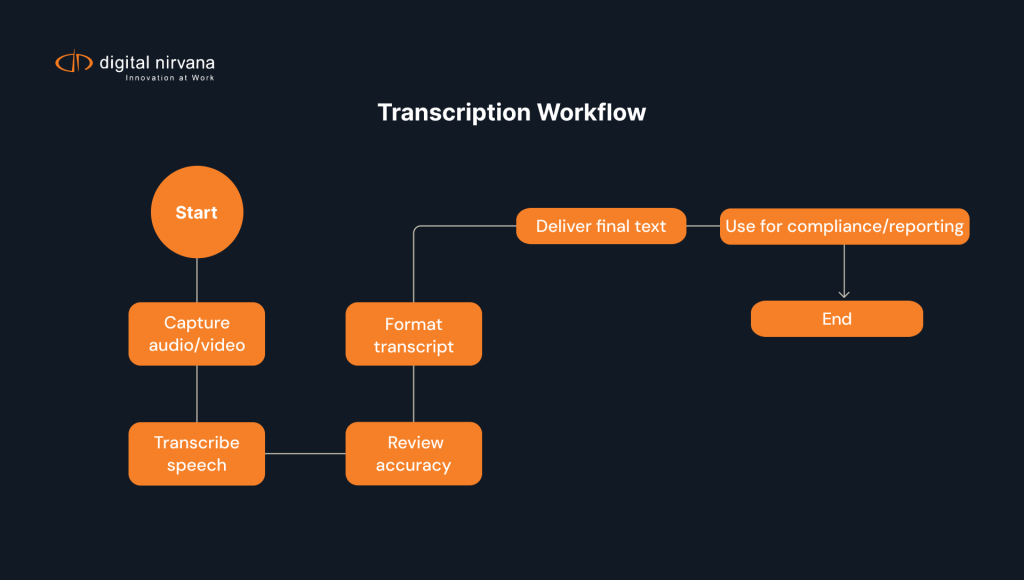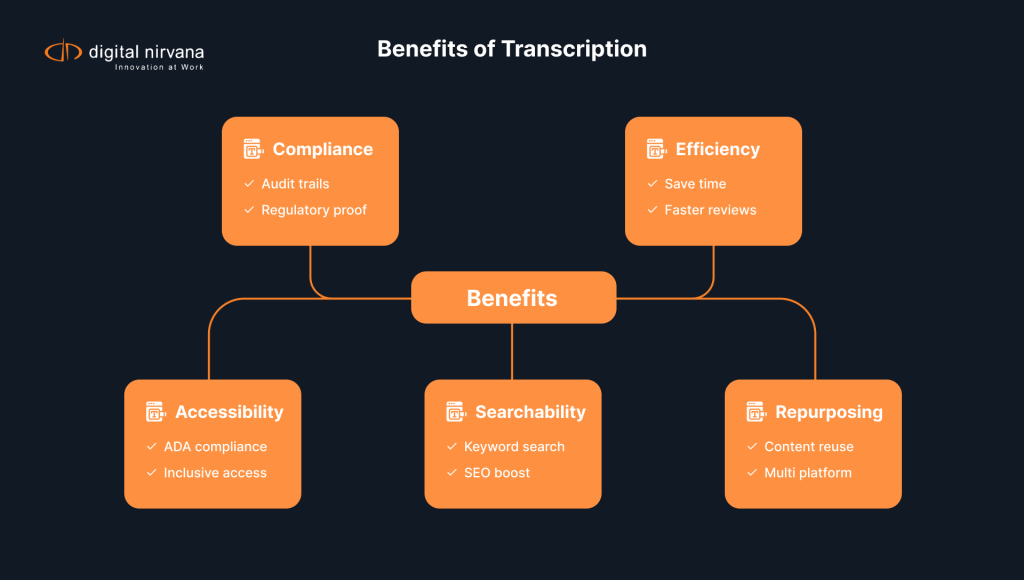Transcription holds weight across industries because it secures compliance, supports legal and audit trails, and makes content accessible for everyone. Regulatory reporting demands precise records, and transcription gives teams accurate documentation that proves accountability. At the same time, it opens access for people with disabilities and turns spoken words into searchable data that drives better decision-making. Businesses across healthcare, law, finance, media, and academia rely on transcription services to work faster, protect data, and meet strict standards without wasting time or resources.
Why transcription is essential for business and compliance
Accurate transcription ensures that businesses record spoken information in a way that meets compliance requirements and supports internal documentation. It transforms meetings, interviews, and hearings into usable records that auditors, regulators, and internal teams can review quickly. Without it, organizations risk missing crucial details or failing to meet reporting standards. Reliable transcription builds accountability, ensures transparency, and strengthens compliance programs. Learn more about MonitorIQ broadcast compliance monitoring from Digital Nirvana, which supports logging and compliance at scale.
What is transcription?
Transcription converts audio or video into written text. Professional transcription services provide multiple formats, including verbatim transcription, edited transcription, intelligent transcription, and phonetic transcription. Each format serves different needs, from capturing every word in a legal deposition to creating readable summaries for internal business use. A proper transcription process eliminates guesswork and replaces vague recollection with hard data. It can also include research transcriptions, research transcribing, and transcription in qualitative research to support academic and compliance requirements.
How transcription supports audit trails and regulatory reporting
Audit trails rely on clear records that can be retrieved and reviewed. Transcription helps maintain logs of meetings, financial discussions, or compliance-related events. When auditors request proof, organizations can present interview transcripts, focus groups transcription, or transcription projects that demonstrate compliance with regulations such as PCI DSS or HIPAA. This builds trust with regulators and clients while reducing risk.
The importance of transcription in accessibility and compliance
Accessibility laws such as the Americans with Disabilities Act require organizations to provide equal access to content. Transcription ensures that people who are deaf or hard of hearing can engage with the same information as others. It also helps businesses meet accessibility requirements while creating a written trail that doubles as a compliance record. Language transcription services extend this inclusion globally.
How Digital Nirvana empowers compliance-driven transcription
Our services at Digital Nirvana make transcription part of a broader compliance strategy. We provide advanced solutions such as MonitorIQ for broadcast compliance logging, Metadatiq for metadata automation, and Trance for captioning and subtitling. Each solution strengthens audit trails, reporting, and accessibility. By pairing AI tools with professional review, we help clients achieve compliance without sacrificing accuracy or efficiency.

How transcriptions enhance speech recordings
Speech recordings often lack the clarity and usability that written text provides. Transcription gives those recordings new purpose by catching details, creating actionable material, and saving teams valuable time. Instead of replaying an hour-long recording, staff can review the transcript in minutes. For related insights, read Digital Nirvana’s blog on How Metadata Enhances Media Workflows.
Catch every detail the first time around
Spoken conversations move quickly, and important details can slip past listeners. Transcription captures everything said, ensuring that no words, names, or figures are lost. Verbatim transcription is especially useful in legal, medical, and research fields where precision is critical. This includes capturing dialects, cues, and spelling words accurately.
Make content instantly actionable for audit purposes
When a compliance officer needs proof, transcription turns speech into clear, referenced records. Instead of sifting through audio files, they can highlight and extract the exact segment that proves compliance with regulatory requirements. Templates and text formats help streamline compliance reporting.
Spend more time on the work that actually matters (analysis over transcription)
Professionals add value through analysis, not transcription. By outsourcing transcription services or using transcription tools, teams can skip the repetitive typing and focus on reviewing findings, making strategic decisions, and preparing reports that move business forward. Researchers, in particular, gain more time for coding and analyzing research data. Learn more from our blog on AI in Media Monitoring.

Transcription enhances accessibility and inclusivity
Accessibility is more than a regulatory checkbox. Transcription creates inclusion by ensuring everyone, regardless of ability, can engage with audio or video content. This supports diverse audiences and strengthens compliance with accessibility laws.
Transcription for accessibility, making content accessible to all
For individuals with hearing disabilities, transcripts provide equal participation. For non-native speakers, transcripts serve as helpful guides. Accessibility through transcription widens the audience and demonstrates corporate responsibility. Subtitles complement transcription for inclusivity.
Captions vs transcripts: which meets compliance and accessibility needs
Captions provide real-time visibility of speech, while transcripts deliver complete records. Captions meet instant needs, but transcripts ensure long-term usability for legal, educational, or compliance purposes. Together, they form a strong accessibility solution.
Why both captions and transcripts benefit users with disabilities
Captions support immediate comprehension, but transcripts allow for deeper review. People with disabilities benefit from both because they offer choice, flexibility, and full control over how they consume information. For more, see our blog on Hybrid Dubbing for Media Workflows.
Transform content into searchable, actionable assets
Transcripts turn speech into structured data that powers search, analysis, and discovery. What once was locked inside recordings becomes content that teams can repurpose and study with ease.
Make research content accessible and searchable
Researchers waste time replaying recordings when they lack transcripts. Transcription transforms recordings into searchable documents that help locate quotes, findings, and details without wasted effort. This applies to transcription interviews, qualitative research, and focus group sessions.
Boost SEO and content discoverability with transcripts
Websites with transcripts perform better in search engines. Transcripts add keyword-rich content that boosts SEO, making webinars, podcasts, and interviews easier to find online. Artificial intelligence tools now help improve indexing.
Enable clickable, interactive transcripts for ease of use
Modern transcription tools create interactive transcripts where each word links back to the original audio. This interactivity helps professionals quickly cross-check context without replaying entire recordings. For a deeper look, see our blog on Metadata Services in Enterprise Media.
Types of transcription and their strategic uses
Different transcription types serve different needs. Choosing the right format ensures accuracy, compliance, and usability.
Verbatim transcription vs edited vs intelligent vs phonetic
- Verbatim transcription captures every word, pause, and filler sound. Perfect for legal and compliance needs.
- Edited transcription corrects grammar and removes fillers, making it readable for business purposes.
- Intelligent transcription summarizes content into concise, clear records for quick review.
- Phonetic transcription captures sound-based detail, often used in linguistics, dialects, and nuanced language research.
Choosing the right transcription tools and services, transcription tools, transcription service, professional transcription
Professional transcription services deliver higher accuracy compared to automated tools. Businesses should weigh costs, accuracy needs, and industry requirements when choosing between professional transcription, DIY transcription tools, or hybrid approaches. Specialized transcribers bring domain expertise.
The transcription process from start to finish
The transcription process includes capturing audio, converting it into text, reviewing accuracy, and delivering the final transcript. Each step ensures compliance and usability.
The transcription process from audio or video to usable text
Audio files move through transcription tools or services, which convert them to text. Professional transcriptionists then review the transcript to ensure accuracy, especially for specialized terminology. Integration of transcription projects into workflows adds efficiency.
Using professional transcription services vs DIY transcription tools
Professional transcription services offer higher accuracy, compliance, and confidentiality, while DIY transcription tools provide affordability and speed. Companies often use a mix, relying on AI transcription tools for speed and professional services for critical compliance needs.
Challenges of transcription and how to overcome them
Transcription faces challenges such as accuracy in noisy recordings or compliance with accessibility laws. Businesses must anticipate these challenges and address them with the right tools and processes.
Accuracy issues in AI generated transcripts
AI transcription tools often misinterpret accents, jargon, or technical terms. Professional review ensures transcripts meet accuracy standards required for compliance.
Specialized terminology and complex audio recordings
Industries like medicine or law require precise transcription of specialized terms. Professional transcription services with domain expertise ensure that transcripts meet these standards.
Ensuring compliance with accessibility regulations during transcription
Accessibility regulations mandate equal access. Transcripts must meet formatting standards, accuracy requirements, and availability rules to ensure compliance.
Industries and professionals that benefit most from transcription
Many industries rely on transcription services to meet compliance, accessibility, and efficiency needs. Transcription saves time and strengthens accountability.

Academic research, capturing detail, freeing analytical time
Researchers capture interviews, focus groups, and qualitative research transcripts to ensure they never lose important insights. Transcription frees them to focus on analysis, coding, and research data.
Legal, medical, and regulatory sectors, audit trails and compliance records
Lawyers, doctors, and compliance officers depend on transcription for accurate records that stand up in audits, trials, and investigations. Transcription skills and templates streamline their work.
Creators, marketers, and media professionals, content repurposing and searchability
Content creators turn transcripts into blogs, captions, and searchable assets. Marketers use transcripts to repurpose podcasts and webinars into SEO-friendly formats. Subtitles, cues, and nuanced text formats enhance audience reach.
How Digital Nirvana supports transcription needs
At Digital Nirvana, we help organizations handle transcription with efficiency and compliance at the center. Our Trance platform enables accurate captioning and transcription while MonitorIQ ensures broadcast logging compliance. Combined with our AI-powered MetadataIQ, these services streamline compliance reporting, improve accessibility, and make content more actionable.
In summary…
Transcription does more than put words on a page. It protects businesses from compliance risks, makes content accessible to all, and transforms speech into actionable, searchable data.
- Businesses meet compliance requirements with clear audit trails
- Professionals save time by reviewing transcripts instead of audio
- Accessibility standards require transcripts to support inclusivity
- Transcripts boost SEO and online discoverability
- Different transcription types serve different industries
- Research transcriptions and transcription interviews enhance academic studies
- Subtitles, cues, and dialects improve accessibility and nuance
In summary, transcription proves critical for compliance, accessibility, and efficiency. Businesses that invest in transcription services gain stronger accountability, faster workflows, and inclusive access for all.
FAQs
How does transcription support audit trails and regulatory reporting?
Transcription creates precise records of conversations, meetings, and hearings that support audit trails and compliance documentation. Regulators and auditors can review transcripts instead of relying on memory or incomplete notes.
What transcription tools and services ensure compliance and accuracy?
Professional transcription services with human review ensure compliance and accuracy. Many companies use transcription tools for speed and combine them with professional review for compliance purposes.
Why is transcription for accessibility mandated, and what standards apply?
Accessibility laws such as the ADA require equal access to information. Transcription ensures compliance by making audio and video content accessible to people with hearing disabilities.
What types of transcription best serve compliance needs?
Verbatim transcription best serves compliance because it captures every word, sound, and pause. This level of detail proves useful in legal, regulatory, and audit settings.
Which industries gain the most value from transcription?
Industries such as healthcare, law, finance, academia, and media gain the most from transcription because it saves time, supports compliance, and provides searchable records for decision-making.




